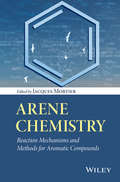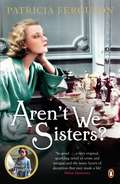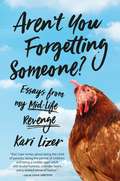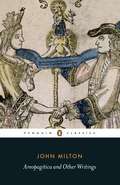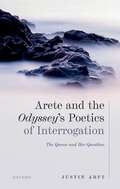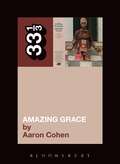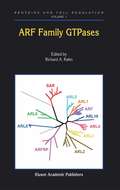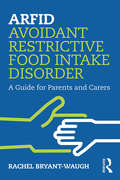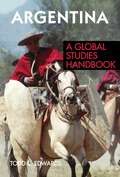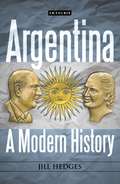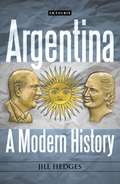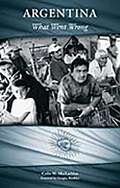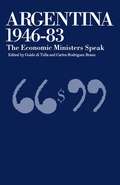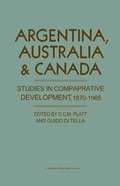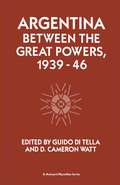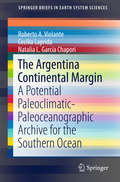- Table View
- List View
Arendt's Solidarity: Anti-Semitism and Racism in the Atlantic World (Cultural Memory in the Present)
by David D. KimHannah Arendt's work inspires many to stand in solidarity against authoritarianism, racial or gender-based violence, climate change, and right-wing populism. But what if a careful analysis of her oeuvre reveals a darker side to this intellectual legacy? What if solidarity, as she conceives of it, is not oriented toward equality, freedom, or justice for all, but creates a barrier to intersectional coalition building? In Arendt's Solidarity, David D. Kim illuminates Arendt's lifelong struggle with this deceptively straightforward yet divisive concept. Drawing upon her publications, unpublished documents, private letters, radio and television interviews, newspaper clippings, and archival marginalia, Kim examines how Arendt refutes solidarity as an effective political force against anti-Semitism, racial injustice, or social inequality. As Kim reveals, this conceptual conundrum follows the arc of Arendt's forced migration across the Atlantic and is directly related to every major concern of hers: Christian neighborly love, friendship, Jewish assimilation, Zionism, National Socialism, the American republic, Black Power, revolution, violence, and the human world. Kim places these thoughts in dialogue with dissenting voices, such as Thomas Mann, Gershom Scholem, Jean-Paul Sartre, James Baldwin, Frantz Fanon, James Forman, and Ralph Ellison. The result is a full-scale reinterpretation of Arendt's oeuvre.
Arene Chemistry: Reaction Mechanisms and Methods for Aromatic Compounds
by Jacques MortierOrganized to enable students and synthetic chemists to understand and expand on aromatic reactions covered in foundation courses, the book offers a thorough and accessible mechanistic explanation of aromatic reactions involving arene compounds.• Surveys methods used for preparing arene compounds and their transformations• Connects reactivity and methodology with mechanism• Helps readers apply aromatic reactions in a practical context by designing syntheses• Provides essential information about techniques used to determine reaction mechanisms
Arene Chemistry: Reaction Mechanisms and Methods for Aromatic Compounds
by Jacques MortierOrganized to enable students and synthetic chemists to understand and expand on aromatic reactions covered in foundation courses, the book offers a thorough and accessible mechanistic explanation of aromatic reactions involving arene compounds.• Surveys methods used for preparing arene compounds and their transformations• Connects reactivity and methodology with mechanism• Helps readers apply aromatic reactions in a practical context by designing syntheses• Provides essential information about techniques used to determine reaction mechanisms
Aren't We Sisters?
by Patricia FergusonFollowing on from The Midwife's Daughter, Aren't We Sisters? is a gripping novel about buried secrets and unlikely friendship.Norah Thornby can no longer afford to live in her grand family home in the centre of Silkhampton. Unless, perhaps, she can find a respectable lodger.But Nurse Lettie Quick is not nearly as respectable as she seems. What's really going on at the clinic she has opened? And why has she chosen Silkhampton?Meanwhile the beautiful Rae Grainger has found the perfect place to stay, in an isolated house miles away from the town. It's certainly rather creepy, especially at candlelit bedtime, but Rae knows that all she has to do is stay out of sight, until others - paid, professional others - are ready to take her little problem away. Then she can just forget the whole ghastly business . . . can't she?No one guesses, of course, that there's a killer quietly at work in Silkhampton; that in one way or another all three women are in danger . . .
Aren't You Forgetting Someone?: Essays from My Mid-Life Revenge
by Kari LizerFrom award-winning TV comedy writer Kari Lizer (The New Adventures of Old Christine) comes a collection of hilarious essays about the challenges of being a woman of a certain age and all that comes with it: empty nest, post #MeToo dating, aging parents, menopausal rage, unrealistic expectations, and eternal optimism. What does it feel like to have your kids leave the house at the same time your parents might need to move in? With self-deprecating humor, sharp wit, and Ephron-esque aplomb, Kari Lizer gives an honest account of finding herself in the middle of growing up, growing old, and still figuring it all out. She finds the wry, bittersweet humor in (almost) all situations--whether it's becoming radioactive during a thyroid cancer treatment, getting fired from her volunteer work, or struggling to find her identity outside of motherhood. Aren't You Forgetting Someone? speaks to those of us who lament the invisibility of the middle-aged woman, but also revel in the unexpected delights of newfound freedom to do whatever the hell we want while no one is looking.
Areolar connective tissue (Large Print)
by RnibThis is a diagram, labelled in Large Print, showing areolar connective tissue. There is a locator dot shown, which will be at the top left of the page when the image is the correct way up.
Areopagitica and Other Writings
by John MiltonJohn Milton was celebrated and denounced in his own time both as a poet and as a polemicist. Today he is remembered first and foremost for his poetry, but his great epic Paradise Lost was published very late in his life, in 1667, and in his own time most readers more readily recognised Milton as a writer of prose. This superbly annotated new book is an authoritative edition of Milton's major prose works, including Of Education, The Tenure of Kings and Magistrates and the Divorce tracts, as well as the famous 1644 polemical tract on the opposing licensing and censorship, Areopagitica.
Areruya and Indigenous Prophetism in Northern Amazonia (New Directions in the Anthropology of Christianity)
by Virgínia AmaralBased on four years of ethnographic research, this book discusses the presence of Christianity on Areruya, an indigenous religious movement practiced by the Ingarikó in Northern Amazonia. Tracing the role of 19th-century missionaries in the region, the book shows how shamans started to announce the coming of a cataclysm, associated with the promise of indigenous salvation in Christian paradise and the acquisition of the colonizers' goods. It also explores how the ancient mythological elaboration of salvation after death was reinforced through both an appropriation of some aspects of Christianity and the development of a very violent form of shamanism, which epitomizes the evilness ascribed to the human condition on earth. Virgínia Amaral offers a valuable reflection on cultural transformations, revealing how Areruya is not only a shamanic appropriation of Christianity, but also an indigenous and ritualized interpretation of colonization.
Areruya and Indigenous Prophetism in Northern Amazonia (New Directions in the Anthropology of Christianity)
by Virgínia AmaralBased on four years of ethnographic research, this book discusses the presence of Christianity on Areruya, an indigenous religious movement practiced by the Ingarikó in Northern Amazonia. Tracing the role of 19th-century missionaries in the region, the book shows how shamans started to announce the coming of a cataclysm, associated with the promise of indigenous salvation in Christian paradise and the acquisition of the colonizers' goods. It also explores how the ancient mythological elaboration of salvation after death was reinforced through both an appropriation of some aspects of Christianity and the development of a very violent form of shamanism, which epitomizes the evilness ascribed to the human condition on earth. Virgínia Amaral offers a valuable reflection on cultural transformations, revealing how Areruya is not only a shamanic appropriation of Christianity, but also an indigenous and ritualized interpretation of colonization.
Arete and the Odyssey's Poetics of Interrogation: The Queen and Her Question
by Justin ArftArete and the Odyssey's Poetics of Interrogation explores how the enigmatic Phaeacian queen, Arete, is at the heart of an epic-scale "poetics of interrogation" used throughout the Odyssey to negotiate Odysseus' kleos, or epic renown. Arete's interrogation of Odysseus has been especially problematic in scholarship, but diachronic and synchronic analysis of similar interrogations across Indo-European, Orphic, and Greek epigrammatic corpora show that the "stranger's interrogation" is a formula that demands performance and negotiation of status. Within the Odyssey, this interrogation is part of an intraformular network used to generate kleos, and the queen's question initiates the longest and most complex negotiation of Odysseus' status in epic and memory. Arete's role as interrogator not only explains her strange authority and resonance with both Penelope and comparative afterlife figures, but it also establishes a gendered, agonistic tension between she and her husband, Alkinoos, that influences the structure, genre, and narratology of performances across the Phaeacian episode. This book reinterprets the Odyssey's central episode and challenges several assumptions about Nausikaa and Alkinoos' famed hospitality, even demonstrating how the Apologue is organized as a response to competing inquiries into Odysseus' fundamental status in tradition. The Odyssey ultimately navigates away from Odysseus' public reputation and roots his status in private memories, and Arete's carefully arranged interventions signal the larger process by which the Odyssey immortalizes Odysseus in poetry as a nostos hero. The queen and her question invite new applications of oral poetics that shed light on the structure, composition, and reperformance of the Odyssey.
Arete and the Odyssey's Poetics of Interrogation: The Queen and Her Question
by Justin ArftArete and the Odyssey's Poetics of Interrogation explores how the enigmatic Phaeacian queen, Arete, is at the heart of an epic-scale "poetics of interrogation" used throughout the Odyssey to negotiate Odysseus' kleos, or epic renown. Arete's interrogation of Odysseus has been especially problematic in scholarship, but diachronic and synchronic analysis of similar interrogations across Indo-European, Orphic, and Greek epigrammatic corpora show that the "stranger's interrogation" is a formula that demands performance and negotiation of status. Within the Odyssey, this interrogation is part of an intraformular network used to generate kleos, and the queen's question initiates the longest and most complex negotiation of Odysseus' status in epic and memory. Arete's role as interrogator not only explains her strange authority and resonance with both Penelope and comparative afterlife figures, but it also establishes a gendered, agonistic tension between she and her husband, Alkinoos, that influences the structure, genre, and narratology of performances across the Phaeacian episode. This book reinterprets the Odyssey's central episode and challenges several assumptions about Nausikaa and Alkinoos' famed hospitality, even demonstrating how the Apologue is organized as a response to competing inquiries into Odysseus' fundamental status in tradition. The Odyssey ultimately navigates away from Odysseus' public reputation and roots his status in private memories, and Arete's carefully arranged interventions signal the larger process by which the Odyssey immortalizes Odysseus in poetry as a nostos hero. The queen and her question invite new applications of oral poetics that shed light on the structure, composition, and reperformance of the Odyssey.
Aretha Franklin's Amazing Grace (33 1/3)
by Aaron CohenA fascinating and thoroughly researched exploration of the best-selling gospel album of all time.
Aretha Franklin's Amazing Grace (33 1/3)
by Aaron CohenA fascinating and thoroughly researched exploration of the best-selling gospel album of all time.
ARF Family GTPases (Proteins and Cell Regulation #1)
by Richard A. KahnFor the first time experts in the area of signalling research with a focus on the ARF family have contributed to the production of a title devoted to ARF biology. A comprehensive phylogenetic analysis of the ARF family, tables of the ARF GEFs and ARF GAPs, and more than a dozen chapters describing them in detail are provided. The impact of the ARF proteins on widely diverse aspects of cell biology and cell signalling can be clearly seen from the activities described; including membrane traffic, lipid metabolism, receptor desensitization, mouse development, microtubule dynamics, and bacterial pathogenesis. Anyone interested in understanding the complexities of cell signalling and the integration of signalling networks will benefit from this volume.
ARFID Avoidant Restrictive Food Intake Disorder: A Guide for Parents and Carers
by Rachel Bryant-WaughARFID Avoidant Restrictive Food Intake Disorder: A Guide for Parents and Carers is an accessible summary of a relatively recent diagnostic term. People with ARFID may show little interest in eating, eat only a very limited range of foods or may be terrified something might happen to them if they eat, such as choking or being sick. Because it has been poorly recognised and poorly understood it can be difficult to access appropriate help and difficult to know how best to manage at home. This book covers common questions encountered by parents or carers whose child has been given a diagnosis of ARFID or who have concerns about their child. Written in simple, accessible language and illustrated with examples throughout, this book answers common questions using the most up-to-date clinical knowledge and research. Primarily written for parents and carers of young people, ARFID Avoidant Restrictive Food Intake Disorder includes a wealth of practical tips and suggested strategies to equip parents and carers with the means to take positive steps towards dealing with the problems ARFID presents. It will also be relevant for family members, partners or carers of older individuals, as well as professionals seeking a useful text, which captures the full range of ARFID presentations and sets out positive management advice.
ARFID Avoidant Restrictive Food Intake Disorder: A Guide for Parents and Carers
by Rachel Bryant-WaughARFID Avoidant Restrictive Food Intake Disorder: A Guide for Parents and Carers is an accessible summary of a relatively recent diagnostic term. People with ARFID may show little interest in eating, eat only a very limited range of foods or may be terrified something might happen to them if they eat, such as choking or being sick. Because it has been poorly recognised and poorly understood it can be difficult to access appropriate help and difficult to know how best to manage at home. This book covers common questions encountered by parents or carers whose child has been given a diagnosis of ARFID or who have concerns about their child. Written in simple, accessible language and illustrated with examples throughout, this book answers common questions using the most up-to-date clinical knowledge and research. Primarily written for parents and carers of young people, ARFID Avoidant Restrictive Food Intake Disorder includes a wealth of practical tips and suggested strategies to equip parents and carers with the means to take positive steps towards dealing with the problems ARFID presents. It will also be relevant for family members, partners or carers of older individuals, as well as professionals seeking a useful text, which captures the full range of ARFID presentations and sets out positive management advice.
Argentina: A Global Studies Handbook (Global Studies: Latin America & the Caribbean)
by Todd L. EdwardsThis work is a unique exploration of modern Argentina, combining narrative historical chapters with a reference section covering the nation's most important cultural figures, places, and events.Argentina: A Global Studies Handbook is a revealing look at South America's second largest nation, providing an interdisciplinary introduction to the country's economy, history, geography, politics, government, society, and culture.Argentina spans over five centuries of the nation's evolution—from the arrival of the conquistadors through the years of revolution and independence, from the Peron era and the often difficult post-Peron transitioning, to the surprising success of current president Néstor Kirchner. The book features both narrative chapters on the country's history and culture, and a reference section with alphabetically organized entries on important people, places, events, and more. There is no better place to begin an investigation of Argentine society and culture, its rich artistic traditions and volatile politics, and the dramatic history that shaped the nation as it is today.
Argentina: A Modern History
by Jill HedgesIn the early 20th century, Argentina possessed one of the world's most prosperous economies, yet since then Argentina has suffered a series of boom-and-bust cycles that have seen it fall well behind its regional neighbours. At the same time, despite the lack of significant ethnic or linguistic divisions, Argentina has failed to create an over-arching post-independence national identity and its political and social history has been marred by frictions, violence and a 50-year series of military coups d'etat. In this book, Jill Hedges analyses the modern history of Argentina from the adoption of the 1853 constitution until the present day, exploring political, economic and social aspects of Argentina's recent past in a study which will be invaluable for anyone interested in South American history and politics.
Argentina: A Modern History
by Jill HedgesIn the early 20th century, Argentina possessed one of the world's most prosperous economies, yet since then Argentina has suffered a series of boom-and-bust cycles that have seen it fall well below its regional neighbours such as Chile. At the same time, despite the lack of significant ethnic or linguistic divisions, Argentina has failed to create an over-arching post-independence national identity and its political and social history has been marked by frictions, violence and a 50-year series of military coups d'état. Such difficulty in defining and resolving a common past has increased the complexity of resolving a national project for the present and future.This lack of a national sense of identity, highlighted by continuing frictions between Buenos Aires and the 'interior' over the centralization of power in the capital, is perhaps one factor explaining the enduring attraction of Peronism since its origins in the early 1940s: Juan Peron's maxim, “if I define, I exclude”, provided for a broad form of identification covering a range of different regional, socioeconomic and political experiences. However, it also provided the basis of an amorphous and ideologically vacuous political platform that has eluded precise definition for 50 years, thus distorting the country's entire political spectrum. Jill Hedges here analyses the modern history of Argentina from the adoption of the 1853 constitution until the present day, highlighting the political factionalism, the weakness of and lack of trust in political institutions and economic dependence on foreign capital which have contributed to its political instability and economic fluctuation. Exploring political, economic and social aspects of Argentina's recent past, this book will be invaluable to anyone interested in South American history and politics.
Argentina: What Went Wrong
by Colin M. MacLachlanWhy has Argentina failed so spectacularly, both economically and politically? It is a puzzle because the country seemed to have all the requirements for greatness, including a well-established middle class of professionals. Its failure raises the specter that other middle-class societies could also fail. In Argentina, MacLachlan delivers history with a plot, a sense of direction and purpose, and fascinating conclusions that reveal a much more complex picture of Argentina than one might have had in mind prior to reading this book.Argentina traces the roots of the nation from the late colonial period to the present, and examines the impact of events that molded it: the failure of political accommodation in 1912, the role of the oligarchy, the development of a middle class, gender issues, the elaboration of a distinct culture, the era of Peron, the army, and the dirty war. The conclusion suggests the reasons for the nation's difficulties. The IMF, World Bank, and international financial markets play a role, but so does a high level of political corruption and mismanagement of the economy that emerged from political and economic failure. Juan and Eva Peron tried to override politics to create an economic and social balance between urban labor and agriculture interests, but failed. The dirty war arose from that failure. Nationalism forged a culture of victimization and resentment that continues to this day. Laying aside standard explanations, MacLachlan presents a portrait of Argentina that emphasizes the role of a destructive nationalism—and a form a corruption that turns citizens into clients.
Argentina, 1946-83: The Economic Ministers Speak (St Antony's Series)
by Guido Di Tella Carlos BraunRepresenting the speeches and papers given by ministers or other authorities at the symposium on Argentina's Economic Policy 1946-1983 held in Toledo, Spain, this collection spans both the economic and political dimensions of the development of Argentinian economic policies.
Argentina Australia And Canada: Studies In Comparative Development 1870-1965 (St Antony's Series)
by Guido Di Veronica Pacini-Ketchabaw D C PlattArgentina Between the Great Powers, 1939-46 (St Antony's Series)
by Guido Di Tella D.Cameron WattAn examination of Argentina's international behaviour during World War II. Relationships with the UK, the USA and Germany are considered, and in particular, the USA's long term hostile attitude towards the only country in Latin America that tried to question the American hegemony over the region.
The Argentina Continental Margin: A Potential Paleoclimatic-Paleoceanographic Archive for the Southern Ocean (SpringerBriefs in Earth System Sciences)
by Roberto A. Violante Cecilia Laprida Natalia L. García ChaporiThe evolution of the Argentina Continental Margin during the Quaternary and the stratigraphic and morphosedimentary configuration responded to climatic variability, oceanographic changes, glacioeustatic fluctuations and tectono-isostatic processes, which began to impact on the margin during previous geological periods. The final modeling of the margin was achieved in the late Miocene, when the interaction between the Antarctic and North Atlantic water-masses favored climatic and oceanographic changes with a profound effect on morphosedimentary features. In the Quaternary, the different regions of the margin distinctly responded to such changes. Whereas in the shelf the main modeling factors were the sea-level fluctuations of glacioeustatic origin and consequent marine-continental stratigraphic records, in the slope (particularly in the sector corresponding to the passive margin) the prevailing effect was the interaction between water-masses and the sea floor, giving origin to contouritic depositional systems accompanied of gravity processes responsible of turbiditic and mass-wasting deposits. Different relationships between contouritic and turbiditic facies respond to distinct combinations of oceanic circulation variability and the indirect effect on the sea floor of sea-level fluctuations.As a result of this complexity in the regional processes in the framework of the broad hemispheric oceanographic-climatic conditioning factors, the ACM can be considered as a complete archive for the Southern Ocean.

